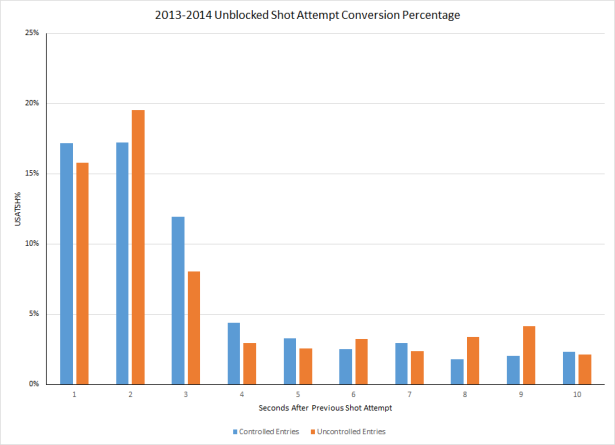
Long has it been argued that sustained zone time is a reliable way to not only prevent your opponents from scoring but as a way to produce offense of your own. The argument that is often made, or at least the one that’s often heard, is that the longer you are in the offensive zone the more likely it is that the defense will become fatigued and make a mistake that leaves someone open for a prime scoring opportunity.
So let’s test that theory by asking a more data driven question; does sustained zone time lead to an increase in shooting percentage?
In order to answer that question we will need a few pieces of information:
- When did a team enter the offensive zone?
- How much time passed between the zone entry and the eventual shot attempt?
- What was the outcome of the shot attempt?
Once we are able to answer those questions we should be able to answer the question that we really want to answer. Does sustained zone time lead to an increase in shooting percentage?
Luckily for us the information needed to answer those questions is out there. The zone entry data that we used was obtained from the hard work of both Corey Sznajder, whose project can be found here, and the illustrious Muneeb Alam.
Let’s start by taking a broad look at offense following zone entries.

Over 42% of all five-on-five goals were scored within five seconds of a zone entry and it’s noteworthy, albeit expected, that the majority of early offense occurs after entries with control. Here is a look at what we’re really interested in, a five second rolling graph of unblocked shot attempt shooting/conversion percentage.

Let’s put the late spike aside for now and focus on the much larger samples in the first 45 seconds as, on the whole, shooting percentage remains pretty noisy throughout.
Unblocked Shot Attempt Conversion Percentage (USATSH%) appears to be relatively independent of the amount of offensive zone time that occurred before the USAT was fired . That’s particularly interesting because Alex Novet identified a strong correlation between unblocked shooting percentage and the number of proceeding unblocked shot attempts in the same zone entry.

Alex’s methodology included USATs from an offensive zone faceoff as part of the USAT total of the proceeding entry, the above graph doesn’t.
Unblocked Shot Attempt Conversion Percentage is higher both in controlled and uncontrolled entries after the first unblocked shot attempt. What we don’t know is what’s fueling that uptick in shooting. The first, and most obvious, place to look is rebounds.

There is a clear increase in shooting percentage in the three seconds following an initial shot attempt but that isn’t really surprising. Rebounds are consistently touted as one of the more reliable ways to produce offense. Seriously, just think about how often during a broadcast you hear that a player has to “go into the dirty areas” if they want to score.
So, based on the graph above let’s assume that any unblocked shot attempt that comes in the first 3 seconds after any shot attempt (blocked or otherwise) is a rebound opportunity. Using that criteria let’s look at the percentage of unblocked shot attempts that constitute a rebound opportunity in a rolling graph.

It appears that the likelihood of generating a rebound opportunity does not increase with sustained zone time. There is an uptick right around the minute mark but the sample at that point is small (12 rebounds in 113 USAT).
So here’s the takeaway: Possession for possession’s sake, or possession that abstains from taking a “lesser” scoring opportunity for the purpose of retaining control of the puck, may have value; but that value doesn’t appear to be related to offense. To put it another way, there is no inherent boost to shooting percentage as the amount of time spent in the offensive zone increases.
Next Steps:
- Determining just how big of a role rebound opportunities play into the overall increase in USATSH% that Alex observed with multiple shot attempt entries
- Evaluate whether sustained zone time has an impact on the chance of a shot attempt being blocked
- Video analysis of goals scored after extended periods of offensive zone time/multiple unblocked shot attempts.
- Explore the idea of sustained zone time leading to a penalty drawn.
If you have any questions or comments feel free to contact me on Twitter

Might be helpful to link extended zone time to PP opportunities generated. This, clearly, will lead to a greater offensive opportunity and increasing the benefits of extended zone time
Might be something worth exploring.
What is intriguing to me is the fatigue caused by defending. Imagine a team is being pressured all game and is hanging in the game (down only a goal), most people in sports know that defending is more physically demanding than attacking. So, I’m wondering if a relentless attack all game impacts scoring chances later in the game.
Interesting thought. What would look at to assess that theory? Total previous shot attempts in the game? Shot attempt differential?